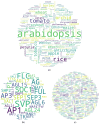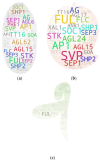An Overview on MADS Box Members in Plants: A Meta-Review
- PMID: 39125803
- PMCID: PMC11311456
- DOI: 10.3390/ijms25158233
An Overview on MADS Box Members in Plants: A Meta-Review
Abstract
Most of the studied MADS box members are linked to flowering and fruit traits. However, higher volumes of studies on type II of the two types so far suggest that the florigenic effect of the gene members could just be the tip of the iceberg. In the current study, we used a systematic approach to obtain a general overview of the MADS box members' cross-trait and multifactor associations, and their pleiotropic potentials, based on a manually curated local reference database. While doing so, we screened for the co-occurrence of terms of interest within the title or abstract of each reference, with a threshold of three hits. The analysis results showed that our approach can retrieve multi-faceted information on the subject of study (MADS box gene members in the current case), which could otherwise have been skewed depending on the authors' expertise and/or volume of the literature reference base. Overall, our study discusses the roles of MADS box members in association with plant organs and trait-linked factors among plant species. Our assessment showed that plants with most of the MADS box member studies included tomato, apple, and rice after Arabidopsis. Furthermore, based on the degree of their multi-trait associations, FLC, SVP, and SOC1 are suggested to have relatively higher pleiotropic potential among others in plant growth, development, and flowering processes. The approach devised in this study is expected to be applicable for a basic understanding of any study subject of interest, regardless of the depth of prior knowledge.
Keywords: MADS box; biotic and abiotic factors; flowering; meta-review; pleiotropic.
Conflict of interest statement
The authors declare no conflicts of interest.
Figures










References
-
- Alvarez-Buylla E.R., Corvera-Poiré A., Garay-Arroyo A., García-Ponce B., Jaimes-Miranda F., Pérez-Ruiz R.V. A MADS view of plant development and evolution. In: Chimal-Monroy J., editor. Topics in Animal and Plant Development: From Cell Differentiation to Morphogenesis. Transworld Research Network; Kerala, India: 2011. pp. 181–220.
Publication types
MeSH terms
Substances
Grants and funding
LinkOut - more resources
Full Text Sources

